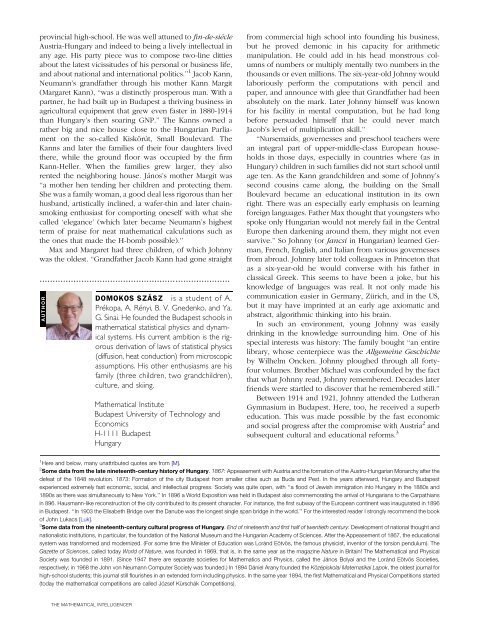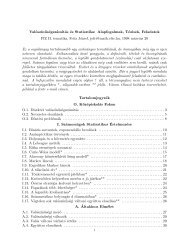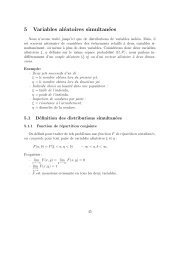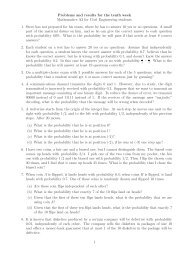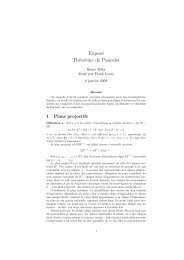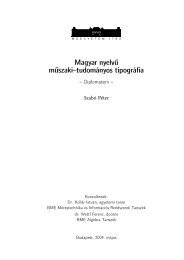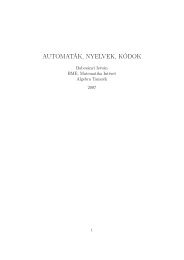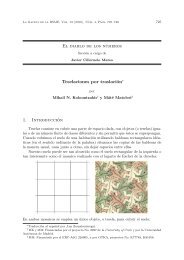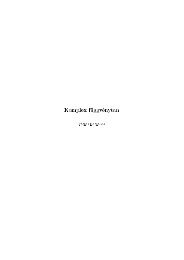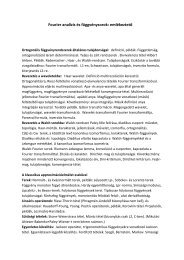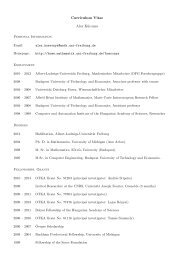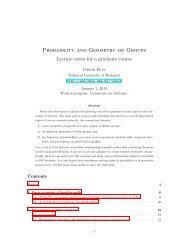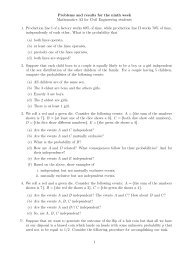John von Neumann, the Mathematician
John von Neumann, the Mathematician
John von Neumann, the Mathematician
You also want an ePaper? Increase the reach of your titles
YUMPU automatically turns print PDFs into web optimized ePapers that Google loves.
provincial high-school. He was well attuned to fin-de-siècle<br />
Austria-Hungary and indeed to being a lively intellectual in<br />
any age. His party piece was to compose two-line ditties<br />
about <strong>the</strong> latest vicissitudes of his personal or business life,<br />
and about national and international politics.’’ 1 Jacob Kann,<br />
<strong>Neumann</strong>’s grandfa<strong>the</strong>r through his mo<strong>the</strong>r Kann Margit<br />
(Margaret Kann), ‘‘was a distinctly prosperous man. With a<br />
partner, he had built up in Budapest a thriving business in<br />
agricultural equipment that grew even faster in 1880-1914<br />
than Hungary’s <strong>the</strong>n soaring GNP.’’ The Kanns owned a<br />
ra<strong>the</strong>r big and nice house close to <strong>the</strong> Hungarian Parliament<br />
on <strong>the</strong> so-called Kiskörút, Small Boulevard. The<br />
Kanns and later <strong>the</strong> families of <strong>the</strong>ir four daughters lived<br />
<strong>the</strong>re, while <strong>the</strong> ground floor was occupied by <strong>the</strong> firm<br />
Kann-Heller. When <strong>the</strong> families grew larger, <strong>the</strong>y also<br />
rented <strong>the</strong> neighboring house. János’s mo<strong>the</strong>r Margit was<br />
‘‘a mo<strong>the</strong>r hen tending her children and protecting <strong>the</strong>m.<br />
She was a family woman, a good deal less rigorous than her<br />
husband, artistically inclined, a wafer-thin and later chainsmoking<br />
enthusiast for comporting oneself with what she<br />
called ‘elegance’ (which later became <strong>Neumann</strong>’s highest<br />
term of praise for neat ma<strong>the</strong>matical calculations such as<br />
<strong>the</strong> ones that made <strong>the</strong> H-bomb possible).’’<br />
Max and Margaret had three children, of which <strong>John</strong>ny<br />
was <strong>the</strong> oldest. ‘‘Grandfa<strong>the</strong>r Jacob Kann had gone straight<br />
.........................................................................<br />
AUTHOR<br />
DOMOKOS SZÁSZ is a student of A.<br />
Prékopa, A. Rényi, B. V. Gnedenko, and Ya.<br />
G. Sinai. He founded <strong>the</strong> Budapest schools in<br />
ma<strong>the</strong>matical statistical physics and dynamical<br />
systems. His current ambition is <strong>the</strong> rigorous<br />
derivation of laws of statistical physics<br />
(diffusion, heat conduction) from microscopic<br />
assumptions. His o<strong>the</strong>r enthusiasms are his<br />
family (three children, two grandchildren),<br />
culture, and skiing.<br />
Ma<strong>the</strong>matical Institute<br />
Budapest University of Technology and<br />
Economics<br />
H-1111 Budapest<br />
Hungary<br />
from commercial high school into founding his business,<br />
but he proved demonic in his capacity for arithmetic<br />
manipulation. He could add in his head monstrous columns<br />
of numbers or multiply mentally two numbers in <strong>the</strong><br />
thousands or even millions. The six-year-old <strong>John</strong>ny would<br />
laboriously perform <strong>the</strong> computations with pencil and<br />
paper, and announce with glee that Grandfa<strong>the</strong>r had been<br />
absolutely on <strong>the</strong> mark. Later <strong>John</strong>ny himself was known<br />
for his facility in mental computation, but he had long<br />
before persuaded himself that he could never match<br />
Jacob’s level of multiplication skill.’’<br />
‘‘Nursemaids, governesses and preschool teachers were<br />
an integral part of upper-middle-class European households<br />
in those days, especially in countries where (as in<br />
Hungary) children in such families did not start school until<br />
age ten. As <strong>the</strong> Kann grandchildren and some of <strong>John</strong>ny’s<br />
second cousins came along, <strong>the</strong> building on <strong>the</strong> Small<br />
Boulevard became an educational institution in its own<br />
right. There was an especially early emphasis on learning<br />
foreign languages. Fa<strong>the</strong>r Max thought that youngsters who<br />
spoke only Hungarian would not merely fail in <strong>the</strong> Central<br />
Europe <strong>the</strong>n darkening around <strong>the</strong>m, <strong>the</strong>y might not even<br />
survive.’’ So <strong>John</strong>ny (or Jancsi in Hungarian) learned German,<br />
French, English, and Italian from various governesses<br />
from abroad. <strong>John</strong>ny later told colleagues in Princeton that<br />
as a six-year-old he would converse with his fa<strong>the</strong>r in<br />
classical Greek. This seems to have been a joke, but his<br />
knowledge of languages was real. It not only made his<br />
communication easier in Germany, Zürich, and in <strong>the</strong> US,<br />
but it may have imprinted at an early age axiomatic and<br />
abstract, algorithmic thinking into his brain.<br />
In such an environment, young <strong>John</strong>ny was easily<br />
drinking in <strong>the</strong> knowledge surrounding him. One of his<br />
special interests was history: The family bought ‘‘an entire<br />
library, whose centerpiece was <strong>the</strong> Allgemeine Geschichte<br />
by Wilhelm Oncken. <strong>John</strong>ny ploughed through all fortyfour<br />
volumes. Bro<strong>the</strong>r Michael was confounded by <strong>the</strong> fact<br />
that what <strong>John</strong>ny read, <strong>John</strong>ny remembered. Decades later<br />
friends were startled to discover that he remembered still.’’<br />
Between 1914 and 1921, <strong>John</strong>ny attended <strong>the</strong> Lu<strong>the</strong>ran<br />
Gymnasium in Budapest. Here, too, he received a superb<br />
education. This was made possible by <strong>the</strong> fast economic<br />
and social progress after <strong>the</strong> compromise with Austria 2 and<br />
subsequent cultural and educational reforms. 3<br />
1 Here and below, many unattributed quotes are from [M].<br />
2 Some data from <strong>the</strong> late nineteenth-century history of Hungary. 1867: Appeasement with Austria and <strong>the</strong> formation of <strong>the</strong> Austro-Hungarian Monarchy after <strong>the</strong><br />
defeat of <strong>the</strong> 1848 revolution. 1873: Formation of <strong>the</strong> city Budapest from smaller cities such as Buda and Pest. In <strong>the</strong> years afterward, Hungary and Budapest<br />
experienced extremely fast economic, social, and intellectual progress. Society was quite open, with ‘‘a flood of Jewish immigration into Hungary in <strong>the</strong> 1880s and<br />
1890s as <strong>the</strong>re was simultaneously to New York.’’ In 1896 a World Exposition was held in Budapest also commemorating <strong>the</strong> arrival of Hungarians to <strong>the</strong> Carpathians<br />
in 896. Hausmann-like reconstruction of <strong>the</strong> city contributed to its present character. For instance, <strong>the</strong> first subway of <strong>the</strong> European continent was inaugurated in 1896<br />
in Budapest. ‘‘In 1903 <strong>the</strong> Elisabeth Bridge over <strong>the</strong> Danube was <strong>the</strong> longest single span bridge in <strong>the</strong> world.’’ For <strong>the</strong> interested reader I strongly recommend <strong>the</strong> book<br />
of <strong>John</strong> Lukacs [Luk].<br />
3 Some data from <strong>the</strong> nineteenth-century cultural progress of Hungary. End of nineteenth and first half of twentieth century: Development of national thought and<br />
nationalistic institutions, in particular, <strong>the</strong> foundation of <strong>the</strong> National Museum and <strong>the</strong> Hungarian Academy of Sciences. After <strong>the</strong> Appeasement of 1867, <strong>the</strong> educational<br />
system was transformed and modernized. (For some time <strong>the</strong> Minister of Education was Loránd Eötvös, <strong>the</strong> famous physicist, inventor of <strong>the</strong> torsion pendulum). The<br />
Gazette of Sciences, called today World of Nature, was founded in 1869, that is, in <strong>the</strong> same year as <strong>the</strong> magazine Nature in Britain! The Ma<strong>the</strong>matical and Physical<br />
Society was founded in 1891. (Since 1947 <strong>the</strong>re are separate societies for Ma<strong>the</strong>matics and Physics, called <strong>the</strong> János Bolyai and <strong>the</strong> Loránd Eötvös Societies,<br />
respectively; in 1968 <strong>the</strong> <strong>John</strong> <strong>von</strong> <strong>Neumann</strong> Computer Society was founded.) In 1894 Dániel Arany founded <strong>the</strong> Középiskolai Matematikai Lapok, <strong>the</strong> oldest journal for<br />
high-school students; this journal still flourishes in an extended form including physics. In <strong>the</strong> same year 1894, <strong>the</strong> first Ma<strong>the</strong>matical and Physical Competitions started<br />
(today <strong>the</strong> ma<strong>the</strong>matical competitions are called József Kürschák Competitions).<br />
THE MATHEMATICAL INTELLIGENCER


